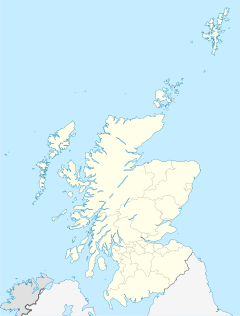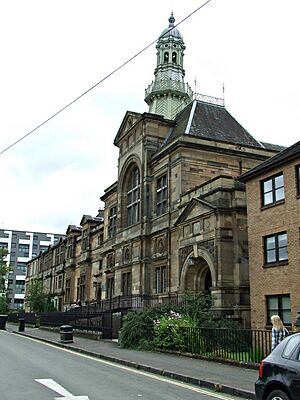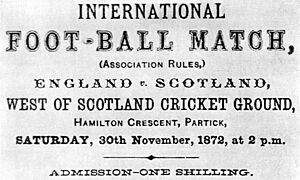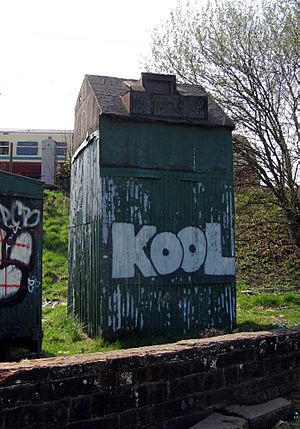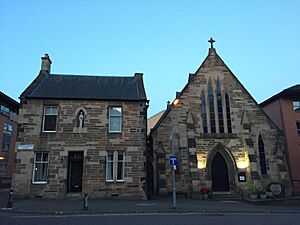Partick facts for kids
Quick facts for kids Partick
|
|
|---|---|
 |
|
| Area | 0.85 km2 (0.33 sq mi) |
| Population | 8,884 (2015) |
| • Density | 10,452/km2 (27,070/sq mi) |
| OS grid reference | NS554665 |
| Council area | |
| Lieutenancy area |
|
| Country | Scotland |
| Sovereign state | United Kingdom |
| Post town | GLASGOW |
| Postcode district | G11 |
| Dialling code | 0141 |
| Ambulance | Scottish |
| EU Parliament | Scotland |
| UK Parliament |
|
| Scottish Parliament | |
Partick (Scots: Pairtick, Cumbric: Peartoc, Scottish Gaelic: Partaig) is a lively area in Glasgow, Scotland. It sits on the north side of the River Clyde, right across from Govan. To its west is Whiteinch, and to the east are Yorkhill and Kelvingrove Park. The River Kelvin flows between Partick and Kelvingrove Park. North of Partick, you'll find areas like Broomhill, Hyndland, Dowanhill, and Hillhead. These areas are all part of Glasgow's "West End."
Partick used to be a separate town with its own local government, called a Police burgh, from 1852 until 1912. In 1912, it became part of the larger city of Glasgow. Partick has strong connections to the Scottish Highlands. Many organizations that promote Scottish Gaelic language and culture, like the Gaelic Books Council, are located here. You might even see Gaelic words on some ATMs in the area!
Contents
What's in a Name? The Etymology of Partick
The name "Partick" comes from a very old language called Cumbric. The original word was Peartoc. This word is similar to the modern Welsh word perth, which means "bush" or "thicket." So, Partick might have been a bushy or thicket-filled place long ago.
Later, the name was adopted into Scottish Gaelic as Peart(h)aig. Today, you might see it as Pearraig or Partaig (which is used on signs at Partick railway station). Older English versions of the name included Perdyc and Perthick. Some believe "Partick" comes from the Gaelic aper dhu ec. This means "the place at the meeting point or mouth of the dark river."
A Look Back: Partick's History
Even though Partick was a small village until the mid-1700s, it has a very long history. The Kings of Strathclyde, who ruled a kingdom in Scotland, had a home here. In 1136, King David I gave the land of Perdyc to the church leaders in Glasgow. The Bishops of Glasgow also had a country house in Partick.
Later, Partick Castle was built in the area. This was a country home for a man named George Hutcheson. The castle was taken down in 1836. Partick had its own local government, based at Partick Burgh Hall. However, in 1912, Partick officially became part of the city of Glasgow.
Exploring Partick: Different Areas
Partick has traditionally been seen as having three main social areas. These include the parts south of Dumbarton Road, north of Dumbarton Road, and the grand homes on Partick Hill. Because Partick is close to the University of Glasgow and the fancy "West End" of Glasgow, many students live here.
In the past, important industries in Partick included shipbuilding. The huge Meadowside Granary, a large building for storing grain, also employed many people. This building was recently taken down to make way for new homes at Glasgow Harbour. Dumbarton Road is the main street in Partick. It has many shops and services for local residents.
Partick's Community Life
Partick Burgh Hall is a popular place in Partick. It's like a community centre where many local events happen. Culture & Sport Glasgow, part of Glasgow City Council, owns and manages the hall. The hall was first built in 1872 and has several rooms. Staff are always there to help with events and keep things safe. People can also rent the hall for private parties.
The Partick Community Council is an important group that helps with local issues. It's the oldest community group in Partick and has about twenty elected members. Their area covers from Byres Road to Crow Road and from the River Clyde to Highburgh Road. Glasgow City Council provides money to the council each year.
The Community Council does many helpful things, such as:
- Helping to organize Neighbourhood Watch groups.
- Talking to Glasgow City Council about local needs.
- Working to keep the area clean and safe.
Sports in Partick
Partick is famous in sports history! It's home to the West of Scotland Cricket Club's Hamilton Crescent ground. This ground was the location of the first ever international football match. This historic game, between the Scotland and England teams, took place on November 30, 1872.
The football club Partick Thistle was started in the area in 1876. However, they moved to the Maryhill area of Glasgow in 1909. Another team, Partick F.C., also played in the 1870s and 1880s.
Getting Around: Transport in Partick
Partick station is a major transport hub. It's a place where you can switch between local trains, the Glasgow Subway, and local bus services. This station opened in 1979, replacing the older Partickhill railway station. In the past, there were three other stations nearby: Partick Central railway station (which became Kelvin Hall station in 1959), Merkland Street, and Partick West railway station.
The Partick transport hub was updated in 2012. This was because it has great potential as a top-notch place to change between trains, buses, and the Subway. It's also the main changeover station for the Argyle and North Clyde train lines.
Places of Worship in Partick
Partick has an old burial ground for Quakers, called the 'Quakers Graveyard'. It's located at the bottom of Keith Street. This graveyard is now a place visitors can see. It was given to the city of Glasgow and was last used in 1857. Purdon Street, which runs next to Keith Street, is named after John Purdon. He was an important Quaker who lived in Partick in the 1600s. His wife is buried in the graveyard.
The local Church of Scotland churches are Partick South Parish Church and Partick Trinity Church.
Partick's Catholic community attends St Peter's church on Hyndland Street. St Simon's church, on Bridge Street, was built in 1858. It is the third oldest Catholic church in Glasgow.
Famous People from Partick
Many interesting people have connections to Partick, including:
- Billy Connolly, a famous comedian, lived on White Street and Stewartville Street when he was a child. He also went to St Peter's Boys School there.
- Liz Cameron, who served as the Lord Provost of Glasgow (a bit like a mayor).
- Helen Holm, a well-known golfer.
- Bud Neill, a talented cartoonist.


